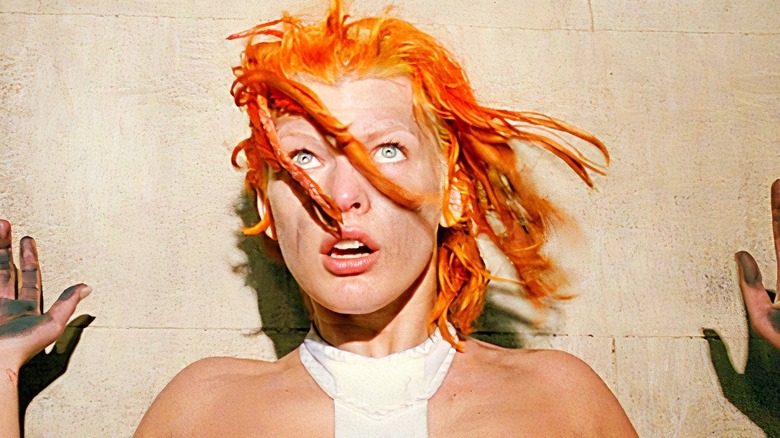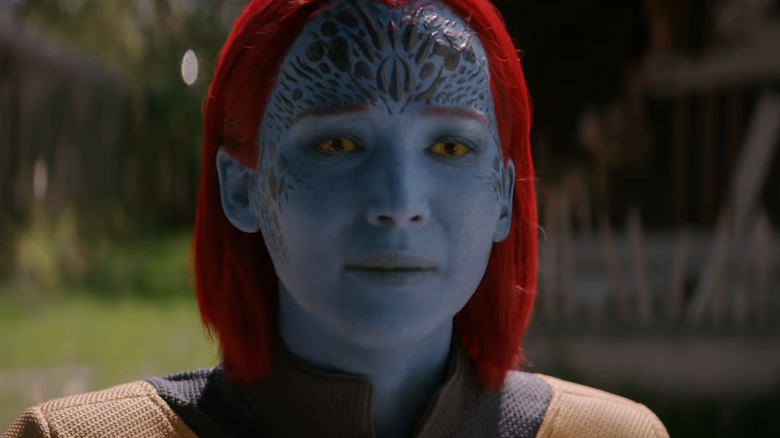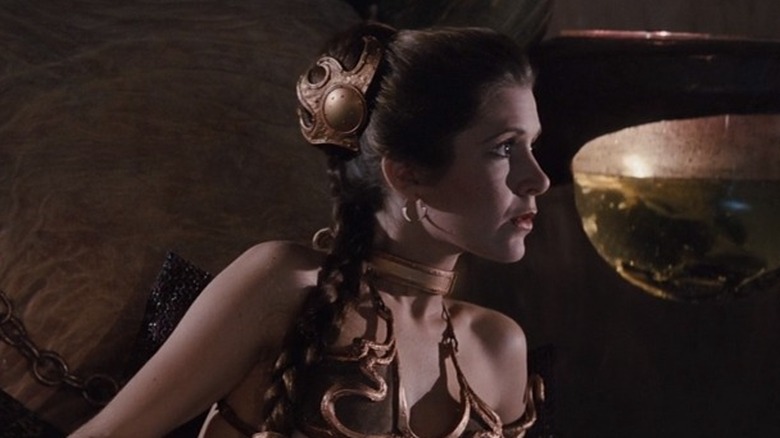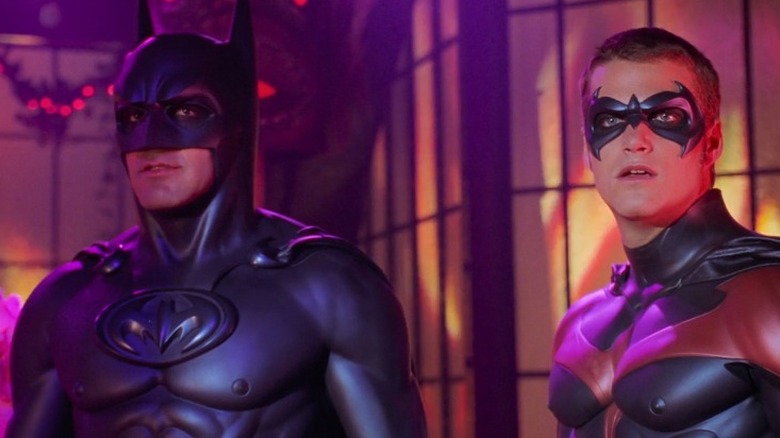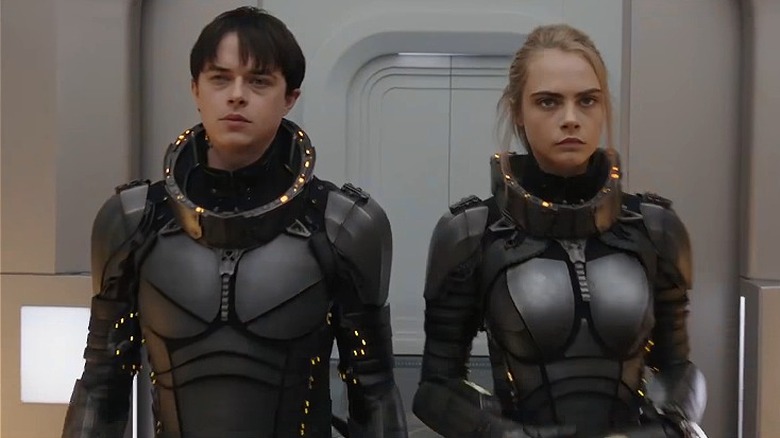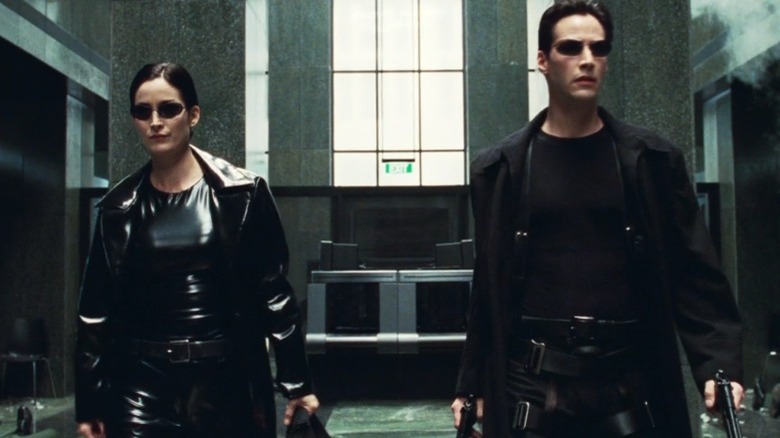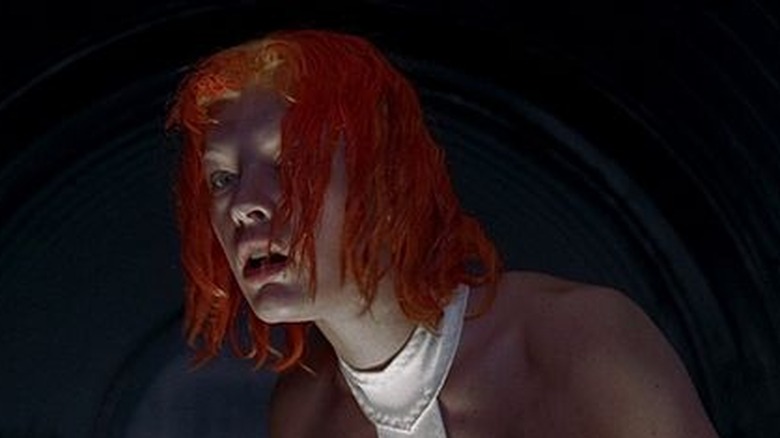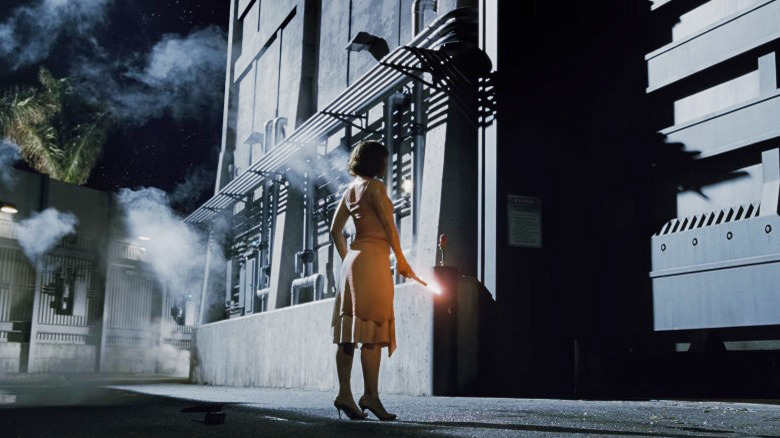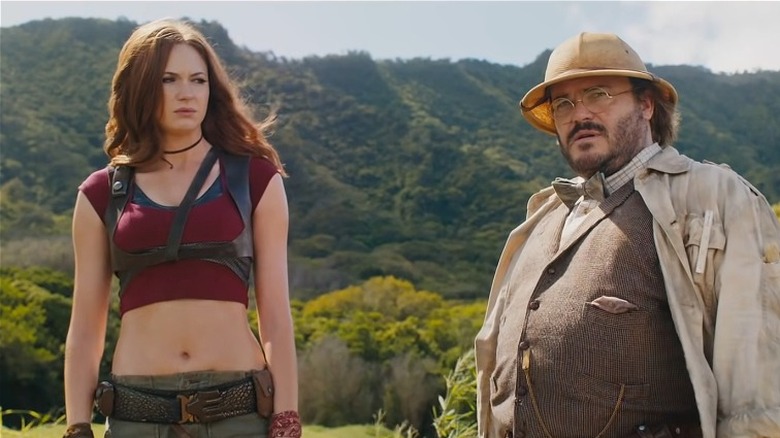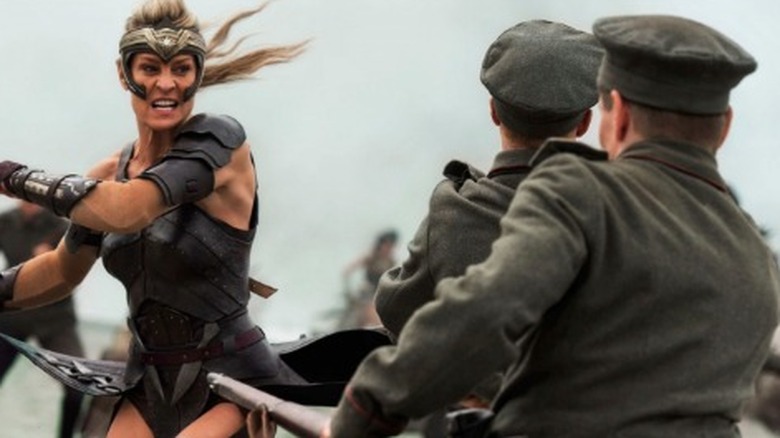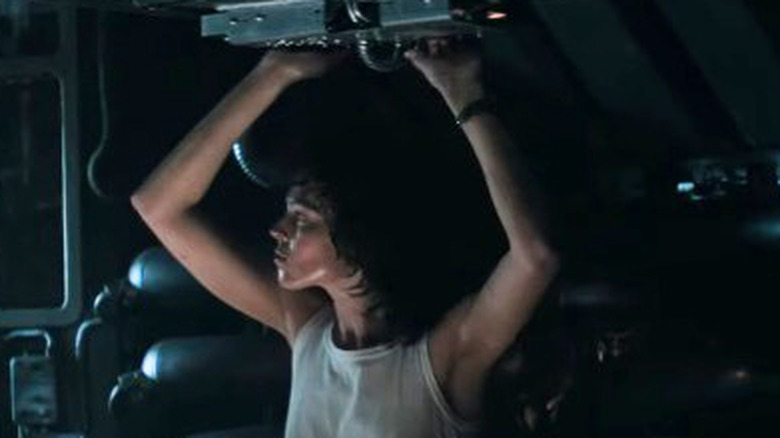The Most Controversial Costumes In Sci-Fi History
Where is the line between representation and exploitation, between strong female characters and ones dressing for the male gaze? Is it empowering to show some skin or a concession for teenage boys? Are bikinis fun for their own sake or are they a blatant grab to sell a poster for a dorm-room wall? It depends on the project, surely, but can two equally-insightful people look at the same character and come away with two polar-opposite reactions to it? This list will convince you that, yes, they absolutely can. These are important questions, though, especially as Hollywood reckons with its long history of sexism, misogyny, and homophobia.
One of the main battlegrounds where these ideological debates play out is in the field of costuming, and more frequently in sci-fi costumes. When filmmakers imagine different worlds, it can be exciting to make your characters on-screen look completely different from how people really dress. Often, though, sci-fi costumes wind up replicating real-life prejudices and structures of power. The outfits here run the gamut historically, but they all have one thing in common: they caused controversy among fans, who have debates in comments sections and across headlines about whether they're iconic or insipid. Sometimes, costumes can even be downright dangerous.
Jennifer Lawrence's Mystique makeup got worse
When Jennifer Lawrence stepped into the role of Mystique for "X-Men: First Class," the character's sleek look was one of the best things about the film. Unfortunately, it seems that the prosthetics and body paint were a lot for the actor to deal with. She told Jimmy Fallon that it originally took eight hours to apply the costume and that they'd gotten it down to three in time for the sequel, "X-Men: Days of Future Past." By "X-Men: Apocalypse," Lawrence was sick of it, and she told Entertainment Weekly she was thinking about bowing out of the franchise because of the character's complicated costuming: "I'm like, 'I can't even pronounce this and that's going in my nose? I'm breathing that?'"
They worked out a compromise to get Lawrence in the franchise's closing chapter, "X-Men: Dark Phoenix," but it wound up being a controversial choice that left a lot of fans fuming. The full-body paint and prosthetics were reduced to the sort of blue face paint and cheap-looking wig that you might buy from Spirit Halloween; less Mystique, more "Superhero Team Blue Lady." Fans, as they are wont to do, took to Twitter to voice their disappointment. One frustrated tweet read: "Jennifer Lawrence as Mystique makes me sad. The Mystique design now is a joke. The character deserves better." The messy costume was mentioned in many reviews of the film, including Comics Beat, which proclaimed, "'Dark Phoenix' is as sloppy as Mystique's makeup." Yikes.
Princess Leia's slave bikini
When audiences were first introduced to Princess Leia in the original "Star Wars" film, "A New Hope," she was wearing a robe and had her hair in buns. A few years later, though, in "Return of the Jedi," Leia's look underwent quite the transformation. After getting captured at Jabba the Hutt's palace while trying to save Han Solo, the princess was clad in a controversial "slave bikini" that set hormonal teenage hearts ablaze and raised a fair few parental eyebrows.
Star Carrie Fisher, of course, had a lot to say about the iconic costume over the years. In characteristically-frank fashion, she wrote in a 1999 essay for Newsweek that the outfit was "what supermodels will eventually wear in the seventh ring of hell." When Daisy Ridley took up the "Star Wars" mantle for Disney's sequel trilogy, Fisher cautioned her not to let the character's impact be sidetracked by her clothing. "Don't be a slave like I was," she warned. Fisher also told The Wall Street Journal that the father who was apparently upset about what he was supposed to tell his kids was "stupid," adding, "Tell them that a giant slug captured me and forced me to wear that stupid outfit, and then I killed him because I didn't like it. And then I took it off. Backstage." Fisher sure did have a way with words.
Putting nipples on the Batsuit
No look back at the most controversial costumes in sci-fi history — nay, the history of cinema — would be complete without a mention of the phrase which sends a shiver down the spine of Batman fans everywhere: the nipples on the Batsuit. The films are Joel Schumacher's "Batman Forever" and "Batman & Robin," and the be-nippled Batsuits are the ones worn by Val Kilmer and George Clooney, the latter of whom admitted in a Reddit AMA that he was embarrassed by it. "That's not something you really think about when you're putting it on," he said. "You figure all batsuits have nipples and then you realize yours was really the first." (He was second, but who's counting.)
Schumacher addressed the controversy in an interview with Vice, acknowledging that the nipples would be part of his legacy. "Such a sophisticated world we live in where two pieces of rubber the size of erasers on old pencils, those little nubs, can be an issue," he complained. "It's going to be on my tombstone, I know it." Some fans, though, are decidedly pro-nipple. An article in Them celebrated and reclaimed "Batman & Robin" as camp, but Schumacher expressly denied any intentional gay subtext to his film's sensibility. "If I wasn't gay, they would never say those things," he insisted in an interview with Vulture. Camp classic or the worst thing to happen to superhero films, one thing's for sure: the nipples made their mark.
Cara Delevingne's Valerian metal bust
Luc Besson's "Valerian and the City of a Thousand Planets" is mostly remembered for being a very expensive flop, one that led to massive losses and layoffs for EuropaCorp, but it's quite a fun slice of flashy sci-fi deserving of another look. In addition to colorful special effects and a thrill-ride of a plot, the film features a fun turn from Rihanna as a singing, shape-shifting alien named Bubble, and how many movies can say that?
At the time of its release, "Valerian" was controversial for more than just its poor reviews and even worse box-office returns. Model Cara Delevingne was cast to play Sergeant Laureline, sidekick to Dane DeHaan's Major Valerian. While some reviews noted that her acting (or lack of chemistry with DeHaan) left something to be desired, others could argue that her wide-eyed, eager performance adds something to the wonderful trashiness of it all. Delevingne's costume made headlines ahead of the film's release, with fans of the original "Valérian and Laureline" comics noting that Laureline's outfit in a first-look image was bustier than normal. An editorial in Metro UK typified the backlash, calling the gendered outfit "annoying" and comparing the look unfavorably to Captain Phasma's far more androgynous armor in "Star Wars: Episode VII – The Force Awakens."
The Matrix's trench coats
When "The Matrix" hit cinemas in 1999, the world hadn't seen anything like it. The Wachowskis pioneered "bullet time," made Keanu Reeves a mega-star, and brought Hong Kong-style wire action sequences fully into the American mainstream — and they did it all while outfitting their characters in some seriously badass leather. In short, "The Matrix" was cool, one of the highest compliments you could give something in the '90s. For proof, check these release-day reactions to the film on Ain't It Cool News. "The Matrix is so cool it's not even funny," one fan wrote. "This has to be one of the coolest flicks of the decade."
However, the film's instantly-iconic style also sparked a moral panic about whether its trench coats were inspiring kids to violence. Several weeks after the release of "The Matrix," the country was rocked by the Columbine shooting, carried out by two kids who were said to be part of a nefarious group the media called the "Trenchcoat Mafia." The shooting's supposed connection to the killers' fashion choices made international headlines, including on the BBC. This was debunked later, but the fact that the Columbine killers were not actually part of the "Trenchcoat Mafia" — a harmless group of computer gamers — didn't matter. By 2003, ABC News was asking if "The Matrix" inspires "violent or mentally disturbed individuals to act out sadistic fantasies?" in a roundup of a number of violent incidents supposedly caused, in part, by those coats. That's a question easily answered, ABC: probably not.
Milla Jovovich hated her Fifth Element costume
Luc Besson has another spot on this list, thanks to a particular costuming choice from his classic sci-fi film "The Fifth Element," released in 1997. Designer Jean Paul Gaultier, known as an "enfant terrible" of the fashion world, created more than a thousand different pieces for the film. He dressed everyone in elaborate costuming, from stars Bruce Willis and Milla Jovovich to background extras with only seconds of screentime. The most famous outfit from the film is the bandage costume worn by Jovovich for her character Leeloo. While the costume became instantly iconic, Jovovich's own public statements about the look have shifted over the years.
On the occasion of the film's 20th anniversary, the former supermodel and future sci-fi mainstay told Vogue, "I think our team did the most incredible job with all the costumes, but especially Leeloo. That just became the most unique costume that anyone had ever seen in a sci-fi movie at that point." However, around the time of the film's release, Jovovich initially told Entertainment Weekly that her infamous bandages were "a bit embarrassing." Moreover, the costume led to the actor being harassed. "Those English guys working on the set were whistling and stuff," she relayed about the unfortunate working conditions; one would hope that wouldn't be the case on a film set today. She insisted that fans should be watching the film for Leeloo's character and not her looks, telling the magazine that despite all appearances, "It's not really about her clothes."
Bryce Dallas Howard's infamous Jurassic World heels
Throughout "Jurassic World," manly-man Chris Pratt constantly belittles the more steely, hyper-feminine Bryce Dallas Howard's choice of outfit. More specifically, he focuses often on her high heels, telling her that her footwear is impractical for traipsing around a dinosaur-filled island. True as that may be, Howard's character Claire elects to keep them on, thank you very much, insisting that her outfit doesn't have anything to do with her strength or ability to outrun dinos.
She puts that to the test in the climax of the film when, in a much-mocked scene, she takes off running from a massive T-Rex, heels stomping the ground in slow-mo like she's walking the runway on "RuPaul's Drag Race." So strong was the backlash to the scene that Pratt decided to prove himself capable of running in heels, too, which he did on The Late Late Show with James Corden to much laughter and applause. Howard defended the character's fashion choice in an interview with Yahoo! Movies, explaining that it simply isn't practical for Claire to waste time taking off her shoes when she's perfectly capable of running in them, as the actor did herself on set. "I don't think she would choose to be barefoot. I don't think she would run faster barefoot in the jungle with vines and stones," she explained. "I'm better equipped to run when I have shoes on my feet. So that's my perspective on it."
Karen Gillan's Jumanji outfit
Studios like to release glimpses of their tentpole films far in advance, hopefully getting fans excited about upcoming blockbuster releases through a look at a special effects shot, an iconic star, or, sometimes, a costume. Such was the case when Sony Pictures released an image back in 2017 of the main characters in "Jumanji: Welcome to the Jungle." The image depicted Kevin Hart, Dwayne "The Rock" Johnson, Karen Gillan, and Jack Black standing in the titular jungle. Instead of getting audiences hyped for the movie, though, the image had a different effect. Fans were surprised by how much skin Gillan's costume showed off, her ultra-short shorts and ultra-cropped crop top seeming rather impractical as an outfit for jungle-foraging.
The Hollywood Reporter published a piece putting forward theories as to why Gillan is "so scantily-clad" in the film (to the bemusement of The Rock on Twitter) with the outlet wondering if "part of the plot involves setting the gender equality fight back 20 years?" Gillan responded online about the outfit, saying: "Yes I'm wearing child sized clothes and YES there is a reason! The pay off is worth it, I promise!" The star was teasing the film's plot point that she plays an in-universe video game character. Ethan Anderton got it right back in 2016, noting after the film's first look was released that "Karen Gillan is clearly a makeshift Lara Croft."
Themyscira's armor looked different in Justice League
Patty Jenkins' "Wonder Woman" was praised by fans and critics alike (via Rotten Tomatoes), with many singling out the film's feminist take on its central characters, almost all of whom were women. In particular, the costumes won a lot of praise: the battle armor for the residents of Themyscira actually seemed like armor! Small victories. However, when those characters returned in "Justice League," fans were quick to point out that the armor had changed.
A critic named Aasa T shared a side-by-side comparison on Twitter, showing the costumes in "Wonder Woman" (seen above) right up against the skimpier ones in "Justice League." They pointed out that the original version was designed by Lindy Hemming, a woman, while the ab-baring bikini variants were created by Michael Wilkinson. "Some steps backwards, methinks," they wrote. Even actor Jessica Chastain chimed in on the controversy, writing in a since-deleted tweet, "Hey men, what would you wear to fight? Hint: don't expose your vital organs." One of the Amazon warriors defended the costume while speaking with USA Today, however. "The girls on set, we never thought of [the new costumes] as a sexy version," said Brooke Ence, who played Penthiselea. "It felt a little more glamorous, if anything, because we had bigger, beautiful hair, which I loved."
Ripley's third-act Alien outfit raised eyebrows
Ridley Scott's masterpiece "Alien" includes a number of iconic sci-fi costumes, not least of which was the horrific Xenomorph suit worn by actor Bolaji Badejo. One of its more enduring looks also happens to be one of its simplest: In the third act of the film, desperate to escape, Sigourney Weaver's Ripley shimmies out of her clothes, stripping down to a shirt and underwear. At first, Weaver was all for it, even suggesting that her character should have gone further. In an interview with Films and Filming magazine (per Alien Series), Weaver said, "You see the Alien in its birthday suit the entire film, so I thought it was a cop out having me wear the underwear, and not stripping entirely." However, she noted that she had received backlash for the costume, including people who said she had "demeaned" herself by performing the scenes. "It never occurred to me for a second that people would think my strip exploitive," she claimed.
Weaver wasn't the only one who's now less than enthusiastic about the costuming choice. Director James Cameron, who helmed "Aliens," has also criticized the underwear sequence. In an interview with News.com.au (via The Chronicle), Cameron said he made an effort not to do the same thing in his sequel. No word on how he justifies that "Titanic" scene where Jack draws Rose like one of his French girls.
